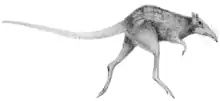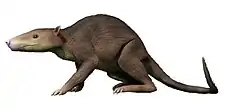Wyonycteris
Wyonycteris is a genus of small mammals that existed in the late Paleocene and early Eocene epochs. The type species is Wyonycteris chalix, which lived in Wyoming during the Clarkforkian North American Land Mammal Age of the Paleocene and was originally proposed to be an early form of insectivorous bat. Later re-examination of the material has put this alliance in doubt, and the genus has instead been proposed as belonging to the subfamily Placentidentinae, within the family Nyctitheriidae.[3] Similar fossil material of the same time period found in Europe was later discovered and described as new species, Wyonycteris richardi.[4]
| Wyonycteris | |
|---|---|
| Scientific classification | |
| Domain: | Eukaryota |
| Kingdom: | Animalia |
| Phylum: | Chordata |
| Class: | Mammalia |
| Order: | Lipotyphla |
| Suborder: | Soricomorpha |
| Family: | †Nyctitheriidae |
| Subfamily: | †Placentidentinae |
| Genus: | †Wyonycteris Gingerich 1987[1] |
| Type species | |
| †Wyonycteris chalix | |
| Species[2] | |
Secord (2008) described the first known species of Wyonycteris from the Tiffanian NALMA, Wyonycteris galensis and W. microtis,[5] although the status of both species as members of Wyonycteris has been questioned.[3][6] The two largest species, W. primitivus and W. kingi, are known from the early Eocene of Mississippi and England, respectively.[3][7]
Evolutionary relationships
Wyonycteris is only known from dental remains. It is characterized by W-shaped crests on the outer side of the upper molars, a trait that it shares with most insectivorous bats.[8] However, Wyonycteris possesses a number of additional cusps on the upper molars that are not present in bats leading many researchers to conclude that it is more closely related to the extinct insectivorous family Nyctitheriidae.[3][7] A recent phylogenetic analysis found most species of Wyonycteris to be within the family Nyctitheriidae, most closely related to the genus Pontifactor.[6] Wyonycteris microtis was found to be very distantly related to the other species of Wyonycteris and outside the family Nyctitheriidae.[6]
Rose et al. (2012) compared Wyonycteris to the genus Plagioctenoides and concluded that the two may in fact belong to the same genus.[9] If this is the case, the correct genus name would be Plagioctenoides since it was formally named first.
Distribution
- Paleocene
- Tiffanian
- Polecat Bench Formation, Wyoming
- Clarkforkian
- Willwood Formation, Wyoming
- Eocene
- Tienen Formation, Belgium
- Woolwich and Blackheath Beds Formations, England
- Argiles d'lignite du Soissonnais Formation, France
- Wasatchian
- Tuscahoma Formation, Mississippi
- Wasatch and Willwood Formations, Wyoming
References
- P. D. Gingerich. 1987. Early Eocene bats (Mammalia, Chiroptera) and other vertebrates in freshwater limestones of the Willlwood Formation, Clark's Fork Basin, Wyoming. Contributions from the Museum of Paleontology, University of Michigan 27(11):275-320
- "Fossilworks: Wyonycteris". fossilworks.org.
- Beard, K. Christopher; Dawson, Mary R. (November 2009). "Early Wasatchian Mammals of the Red Hot Local Fauna, Uppermost Tuscahoma Formation, Lauderdale County, Mississippi". Annals of Carnegie Museum. 78 (3): 193–243. doi:10.2992/007.078.0301. S2CID 86281527.
- Smith, Thierry. (1995). Présence du genre Wyonycteris (Mammalia, Lipotyphla) à la limite Paléocène-Eocène en Europe. Comptes Rendus de l Académie des Sciences - Series IIA - Earth and Planetary Science. 321. 923-930.
- Ross Secord (2008). "The Tiffanian Land-Mammal Age (Middle and Late Paleocene) In The Northern Bighorn Basin, Wyoming". Papers on Paleontology. No. 35. hdl:2027.42/61362.
- Manz, Carly L.; Bloch, Jonathan I. (2015-09-01). "Systematics and Phylogeny of Paleocene-Eocene Nyctitheriidae (Mammalia, Eulipotyphla?) with Description of a new Species from the Late Paleocene of the Clarks Fork Basin, Wyoming, USA". Journal of Mammalian Evolution. 22 (3): 307–342. doi:10.1007/s10914-014-9284-3. ISSN 1573-7055. S2CID 15369336.
- Hooker, Jerry J. (2018-03-30). "A mammal fauna from the Paleocene-Eocene Thermal Maximum of Croydon, London, UK". Proceedings of the Geologists' Association. 131 (5): 458–473. doi:10.1016/j.pgeola.2018.01.001. ISSN 0016-7878. S2CID 134941309.
- Gingerich, Philip D. (1987). "Early Eocene bats (Mammalia, Chiroptera) and other vertebrates in freshwater limestones of the Willwood Formation, Clark's Fork Basin, Wyoming". Contributions from the Museum of Paleontology, University of Michigan. 27: 275–320.
- Kenneth D. Rose; Amy E. Chew; Rachel H. Dunn; Mary J. Kraus; Henry C. Fricke; Shawn P. Zack. "Earliest Eocene mammalian fauna from the Paleocene-Eocene Thermal Maximum at Sand Creek Divide, southern Bighorn Basin, Wyoming". Papers on Paleontology. No. 36. hdl:2027.42/89881.


